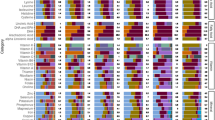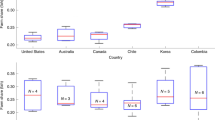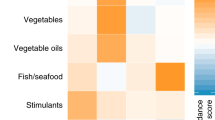Abstract
Humans globally have similar nutritional needs but face large differences in natural resource endowments and local food production. This study quantifies food-system inequality across countries on the basis of natural resource inputs, food/nutrient outputs and nutrition/health outcomes, from 1970 to 2010. Animal source foods and overweight/obesity show rapid convergence while availability of selected micronutrients show slower convergence. However, all variables are more equally distributed than national income per capita, the Gini coefficient of which declined from 0.71 to 0.65. Inequalities in total and animal-source dietary energy declined from 0.16 to 0.10 and 0.55 to 0.36, respectively. There was convergence in overweight/obesity prevalence from 0.39 to 0.27, while undernutrition and stunting became increasingly concentrated in a few high-burden countries. Characterizing cross-country inequalities in agricultural resources, foods, nutrients and health can help identify critical opportunities for agriculture and food policies, as well as prioritize research objectives and funding allocation for the coming decade.
This is a preview of subscription content, access via your institution
Access options
Access Nature and 54 other Nature Portfolio journals
Get Nature+, our best-value online-access subscription
$29.99 / 30 days
cancel any time
Subscribe to this journal
Receive 12 digital issues and online access to articles
$119.00 per year
only $9.92 per issue
Buy this article
- Purchase on Springer Link
- Instant access to full article PDF
Prices may be subject to local taxes which are calculated during checkout







Similar content being viewed by others
Data availability
All data used in this study are publicly available from open sources as indicated in the references in the Methods. Enquiries related to the NBS should be made to K.L. (k.lividini@cgiar.org).
Code availability
All data analysis was carried out in Stata SE 15. All figures were produced in Stata with the exception of Fig. 7 which was produced using Excel. The code used for data analysis and figure production is available from the corresponding author upon reasonable request.
References
Rockström, J., Stordalen, G. A. & Horton, R. Acting in the Anthropocene: the EAT–Lancet Commission. Lancet 387, 2364–2365 (2016).
Bentham, J. et al. Multidimensional characterization of global food supply from 1961 to 2013. Nat. Food 1, 70–75 (2020).
Popkin, B. M. Relationship between shifts in food system dynamics and acceleration of the global nutrition transition. Nutri. Rev. 75, 73–82 (2017).
Khoury, C. K. et al. Increasing homogeneity in global food supplies. Proc. Natl Acad. Sci. USA 111, 4001–4006 (2014).
Hawkes, C., Chopra, M. & Friel, S. in Globalization and Health: Pathways, Evidence and Policy (eds Labonté, R. et al.) Ch. 10 (Routledge, 2009).
Baker, P. & Friel, S. Food systems transformations, ultra-processed food markets and the nutrition transition in Asia. Glob. Health 12, 80 (2016).
Sen, A. in The Tanner Lecture on Human Values 1–26 (Stanford, 1979).
Wagstaff, A., Paci, P. & Van Doorslaer, E. On the measurement of inequalities in health. Soc. Sci. Med. 33, 545–557 (1991).
Harper, S. & Lynch, J. in Methods in Social Epidemiology (eds Oakes, J. M. & Kaufman, J.) Ch. 5 (Jossey-Bass, 2017).
Seekell, D. A., D’Odorico, P. & Pace, M. L. Virtual water transfers unlikely to redress inequality in global water use. Environ. Res. Lett. 6, 024017 (2011).
Guragai, B., Takizawa, S., Hashimoto, T. & Oguma, K. Science of the total environment effects of inequality of supply hours on consumers’ coping strategies and perceptions of intermittent water supply in Kathmandu Valley, Nepal. Sci. Total Environ. 599–600, 431–441 (2017).
Steinberger, J. K., Krausmann, F. & Eisenmenger, N. Global patterns of materials use: a socioeconomic and geophysical analysis. Ecol. Econ. 69, 1148–1158 (2010).
Groot, L. Carbon Lorenz curves. Resour. Energy Econ. 32, 45–64 (2010).
Lawrence, S., Liu, Q. & Yakovenko, V. M. Global inequality in energy consumption from 1980 to 2010. Entropy 15, 5565–5579 (2013).
Gluzmann, P. & Gasparini, L. International inequality in subjective well-being: an exploration with the Gallup World Poll. Rev. Dev. Econ. https://doi.org/10.1111/rode.12356 (2017).
Afshin, A. et al. Health effects of dietary risks in 195 countries, 1990–2017: a systematic analysis for the Global Burden of Disease Study 2017. Lancet 393, 1958–1972 (2019).
Milanovic, B. Worlds Apart: Measuring International and Global Inequality (University Press, 2011).
Milanovic, B. Global Inequality (Belknap, 2016).
Willett, W. C. et al. Food in the Anthropocene: the EAT–Lancet Commission on healthy diets from sustainable food systems. Lancet 393, 447–492 (2020).
Dietary Reference Values for Nutrients. Summary Report EFSA Supporting publication, 2017, e15121 (European Food Safety Authority Panel on Dietetic Products Nutrition & Allergies, 2017).
Global Food Losses and Food Waste—Extent, Causes and Prevention (FAO, 2011).
NCD-RisC. Worldwide trends in blood pressure from 1975 to 2015: a pooled analysis of 1479 population-based measurement studies with 19.1 million participants. Lancet 389, 37–55 (2017).
NCD-RisC Worldwide trends in diabetes since 1980: a pooled analysis of 751 population-based studies with 4.4 million participants. Lancet 387, 1513–1530 (2016).
Herforth, A. et al. Cost and Affordability of Healthy Diets Across and Within Countries. Background Paper for the State of Food Security and Nutrition in the World. FAO Agricultural Development Economics Technical Study No. 9 (FAO, 2020).
Bai, Y., Naumova, E. N. & Masters, W. A. Seasonality of diet costs reveals food system performance in East Africa. Sci. Adv. 6, eabc2162 (2020).
Issues in the Collection of FAO Data (African Commission on Agricultural Statistics, 2013); http://www.fao.org/fileadmin/templates/ess/documents/afcas23/DOC_-_3f__Eng_.pdf
UN Sustainable Development Goals. Universal Values: Leave No One Behind (UN Sustainable Development Group, 2020); https://unsdg.un.org/2030-agenda/universal-values/leave-no-one-behind
UN Sustainable Development Goals. Transforming our World: The 2030 Agenda for Sustainable Development (UN Sustainable Development Group, 2020); https://sustainabledevelopment.un.org/post2015/transformingourworld
Tomich et al. Transforming Agrarian Economies: Opportunities Seized, Opportunities Missed (Cornell, 1995).
Masters, W. A., Rosenblum, N. Z. & Alemu, R. G. Agricultural transformation, nutrition transition and food policy in Africa: Preston curves reveal new stylised facts. J. Dev. Stud. 54, 788–802 (2018).
Matson, P. A., Parton, W. J., Power, A. G. & Swift, M. J. Agricultural intensification and ecosystem properties. Science 227, 504–509 (1997).
Rudel, T. K. et al. Agricultural intensification and changes in cultivated areas, 1970-2005. Proc. Natl Acad. Sci. USA 106, 20675–20680 (2009).
Forouzanfar, M. H. et al. Global, regional and national comparative risk assessment of 79 behavioural, environmental and occupational, and metabolic risks or clusters of risks in 188 countries, 1990–2013: a systematic analysis for the Global Burden of Disease Study 2013. Lancet 386, 2287–2323 (2015).
The State of Food and Agriculture 2019. Moving Forward on Food Loss and Waste Reduction (FAO, 2019).
The State of Food Security and Nutrition in the World 2020. Transforming Food Systems for Affordable Healthy Diets (FAO, IFAD, UNICEF, WFP and WHO, 2020); https://doi.org/10.4060/ca9692en
Wood, S. A. et al. Trade and the equitability of global food nutrient distribution. Nat. Sustain. 1, 34–37 (2018).
Black, R. E. et al. Maternal and child undernutrition and overweight in low-income and middle-income countries. Lancet 382, 427–451 (2013).
NCD-RisC. Trends in adult body-mass index in 200 countries from 1975 to 2014: a pooled analysis of 1698 population-based measurement studies with 19.2 million participants. Lancet 387, 1377–1396 (2016).
NCD-RisC Worldwide trends in body-mass index, underweight, overweight, and obesity from 1975 to 2016: a pooled analysis of 2416 population-based measurement studies in 128.9 million children, adolescents, and adults. Lancet https://doi.org/10.1016/S0140-6736(17)32129-3 (2017).
World Development Indicators (World Bank, accessed November 2019); https://databank.worldbank.org/source/world-development-indicators
FAOSTAT (FAO, accessed November 2019); http://www.fao.org/faostat/en/
Smith, M. R., Micha, R., Golden, C. D., Mozaffarian, D. & Myers, S. S. Global Expanded Nutrient Supply (GENuS) model: a new method for estimating the global dietary supply of nutrients. PLoS ONE 11, e0146976 (2016).
Schmidhuber, J. et al. The Global Nutrient Database: availability of macronutrients and micronutrients in 195 countries from 1980 to 2013. Lancet Plan. Health 2, e353–e368. (2018).
USDA National Nutrient Database for Standard Reference, Legacy (USDA Agricultural Research Service, Nutrient Data Laboratory, 2018); http://www.ars.usda.gov/nutrientdata
World Population Prospects 2018 (UN Department of Economic and Social Affairs, 2019); https://population.un.org/wpp/Download/Standard/Population/
World Urbanization Prospects 2018 (UN Dept. of Economic and Social Affairs, 2019); https://population.un.org/wup/
World Bank Country and Lending Groups (World Bank, 2018); https://datahelpdesk.worldbank.org/knowledgebase/articles/906519-world-bank-country-and-lending-groups
Milanovic, B. The Three Concepts of Inequality Defined, From Worlds Apart: Measuring International and Global Inequality (University Press, 2005).
Pen, J. Income Distribution (Allen Lane, 1971).
Jann, B. Variable bar widths in two-way graphs. Stata J. 15, 316–318 (2015).
ColorBrewer v.2.0 (ColorBrewer, 2013); http://www.ColorBrewer.org
Acknowledgements
We are grateful to A. Dangour and B. Shankar for initiating this project with funding for W.B. and K.L. from the Wellcome Trust (grant number 210794/Z/18/Z). W.M. was supported by the US Agency for International Development (cooperative agreement 720-OAA-18-LA-00003). Any opinions, findings, conclusions, or recommendations expressed here are those of the authors alone.
Author information
Authors and Affiliations
Contributions
W.A.M. conceived the overall study with inputs from W.B. and K.L. W.B. and K.L. assembled the data and developed the model code for the analysis. W.B. drafted the manuscript, K.L. and W.A.M. reviewed and edited the manuscript. All authors contributed to the revisions.
Corresponding author
Ethics declarations
Competing interests
The authors declare no competing interests.
Additional information
Peer review information Nature Food thanks Jody Harris, Shauna Downs and Mark Lundy for their contribution to the peer review of this work.
Publisher’s note Springer Nature remains neutral with regard to jurisdictional claims in published maps and institutional affiliations.
Supplementary information
Supplementary Information
Supplementary Table 1 and Figs. 1–14.
Rights and permissions
About this article
Cite this article
Bell, W., Lividini, K. & Masters, W.A. Global dietary convergence from 1970 to 2010 altered inequality in agriculture, nutrition and health. Nat Food 2, 156–165 (2021). https://doi.org/10.1038/s43016-021-00241-9
Received:
Accepted:
Published:
Issue Date:
DOI: https://doi.org/10.1038/s43016-021-00241-9
This article is cited by
-
Health burden from food systems is highly unequal across income groups
Nature Food (2024)
-
Progress towards healthy diets remains slow
Nature Food (2023)
-
Global food nutrients analysis reveals alarming gaps and daunting challenges
Nature Food (2023)
-
The feasibility of implementing food-based dietary guidelines and food graphics in Ethiopia
Food Security (2023)
-
Tracing global flows of bioactive compounds from farm to fork in nutrient balance sheets can help guide intervention towards healthier food supplies
Nature Food (2022)



